In late 2007, a panic struck the the United States. Mortgage-backed securities, which had become a popular investment in the financial sector, had begun to collapse in value. Many of the subprime borrowers who had received these loans began to stop making payments, and as they did so, the financial world began to teeter on edge.
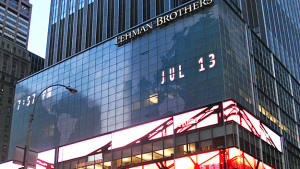 Things came to a head in September of 2008 with the fall of Lehman Brothers, the fourth largest investment bank in the United States. This company had existed since 1850, back when people traveled by horses instead of cars, so you can imagine the shift that was happening to the country at this time.
Things came to a head in September of 2008 with the fall of Lehman Brothers, the fourth largest investment bank in the United States. This company had existed since 1850, back when people traveled by horses instead of cars, so you can imagine the shift that was happening to the country at this time.
The nation fell into an historic recession, a Great Recession that lasted until the middle of 2009 according to the National Bureau of Economic Research (NBER). Everybody nationwide experienced significant loss (Wikipedia):
- Around 15 million Americans lost their jobs as the unemployment rate soared to more than 10%.
- The net worth of households in the country fell by 22%, loosely meaning: Americans lost about a fifth of all they had.
- Retirement funds in the stock market lost 57% of their value in 6 months.
Because of this fallout, people everywhere began to struggle in their financial commitments. With 15 million people out of work, every kind of loan was negatively impacted, from home loans to credit cards:
How might peer to peer lending perform during a recession?
Perhaps this memory is still fresh in your mind. You might wonder how peer to peer lending might perform during a similar national downturn in the economy. Actually, this is one of the most common questions we grapple with in peer to peer lending. How might a loan issued by Lending Club or Prosper perform during a recession?
The Impact of Unemployment on Consumer Credit
To begin to answer that question, we can look at a mature credit industry that did experience both of these recessions: credit cards. Both p2p loans and credit cards are a similar investment: unsecured lines of consumer credit. And if we take the unemployment rate provided by the US Bureau of Labor Statistics and stack it against the return that banks earned on credit cards (interest rates minus default rates provided by the Federal Reserve), an informative picture begins to form:
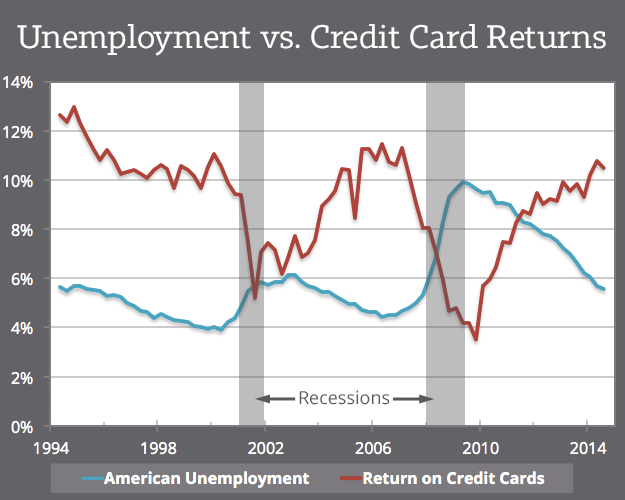
As the nation experiences a recession, the national unemployment rate begins to rise. Then, as people lose their income streams, they also lose their ability to pay their debts. So you can watch the overall return of consumer credit fall during a recession.
As an aside, it’s amazing to note that banks still did not lose money on credit cards during the 2008 recession. The stock market fell 57% in six months, yet major banks kept earning and earning. Related: This Investment has 20 Years of Positive Returns
During a Recession, Credit Card Returns Can Drop 20%
Let’s take a closer look at this data by shaping the credit card return into a rolling three-year average, a figure that more corresponds to the term of a p2p loan.
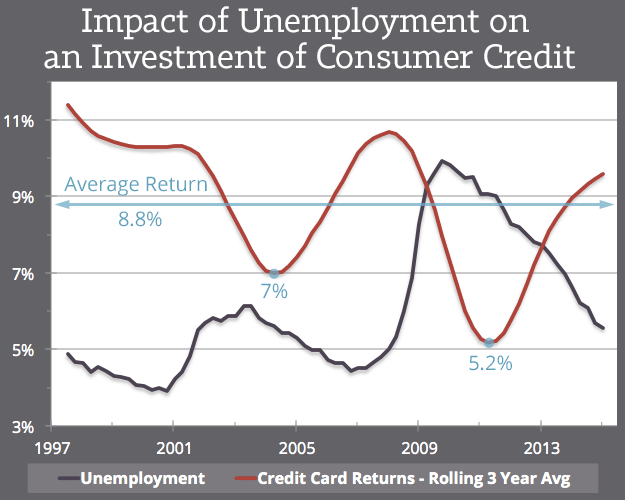
What we see is the average return of 8.8% steadily dropping after each recession:
- After the 2000 recession, avg. credit card returns fell 20% to an ROI of 7%
- After the 2008 recession, avg. credit card returns fell 40% to an ROI of 5.2%
In short, investors never lost money on credit cards, even during the 2008 recession, the worst economic catastrophe since the Great Depression. But returns did steeply dive by 20-40%, depending on the severity of the unemployment rate.
If this is equally felt in peer to peer lending, it could mean:
- A more typical recession may also drop a peer lending return by 20% – say from 6% to 4-5%.
- A more serious recession may also drop a peer lending return by 40% – say from 6% to 3-4%.
Of course, these losses will be easier if investors hold more A-grade loans, and more ugly if investors hold more E-grade loans.
Lending Club During the 2008 Recession
Interestingly, Lending Club was actually issuing loans during this entire recession (Prosper, less so). And while the industry was immature and their credit model somewhat untested, the data is still interesting to look at. Here are all the loans Lending Club issued during this recession (dates via NBER, loan data via NSR):
Peer to peer lending gave investors a positive return during the 2008 recession.
Similar to credit cards, peer to peer lending gave investors a positive return during the 2008 recession, particularly with the help of safer A-grade loans. These loans were issued to safer borrowers with better credit history and employment, and thus were less impacted by the unemployment. On the other hand, riskier D-G grades earned investors an overall negative return of -0.8%.
In contrast to peer to peer lending’s positive return, the S&P 500 lost a third of its value during this same period:
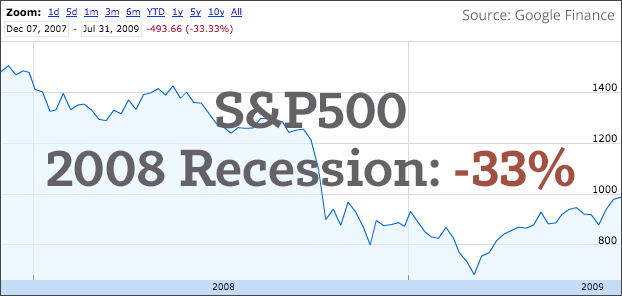
Thus we arrive at the popular 2-part consensus in peer to peer lending: that (1) returns will drop during a recession because of unemployment, but (2) that investors should also earn a positive return. Of course, there is no guarantee this will actually happen, but I think it remains a likely prediction. Further, I think the next recession will be significantly less ugly to p2p returns than before since Lending Club and Prosper’s 2008 credit model was so new and untested.
How a Recession Affects P2P Loan Grades
Let’s finish this by taking the loan grade window and expanding it until today. Unfortunately, the first year where we have enough loans per grade to analyze is actually 2009, but it still gives us a pretty decent look into loan grade performance during a recession.
Here is how every Lending Club grade performed over the past seven years:
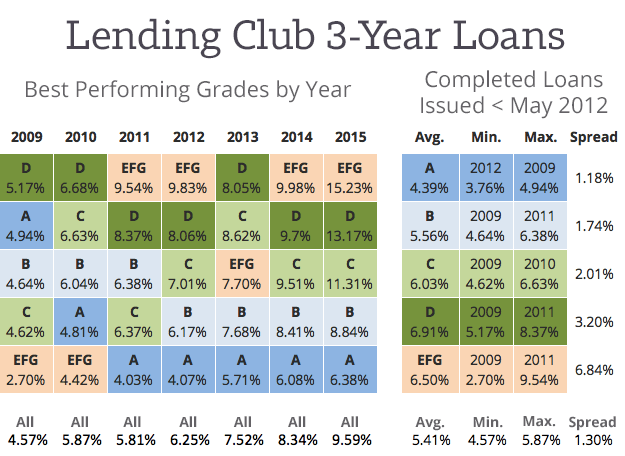
The 2008 recession continued until July 2009, so I would suggest that Lending Club’s returns during this period are a decent window into typical recession performance. By comparison, 2011-2015 represent performance during more healthy economic cycles.
When unemployment rises, the grades reverse to read ABCDE.
What we see is this: during a healthy economic environment the best performing grades are the alphabet in reverse — EDCBA. But when unemployment rises, the grades reverse to read ABCDE. During recessions, the riskier loan grades earn the worst return. During healthier economic times, the riskier loan grades earn the greatest return.
Additionally, I find the All loan data at the bottom very interesting. Though the return is a full point higher than A-graded loans, the spread (worst year vs. best year) is almost the same. This shows the benefits of diversifying across loan grades, treating them like subgrades of stocks (small cap, medium cap, etc). The grade-diversification potentially gives an increased return without much of an increase in risk.
How much loss can you tolerate?
In conclusion, it is impossible to perfectly predict how peer to peer lending will perform during a recession. Perhaps returns will drop 1-3% like credit cards. We honestly don’t know. What we can say with a fair amount of certainty is that safer loans will be less impacted.
The question you should be asking yourself is this: How much loss can I tolerate? Am I willing to invest in peer to peer lending if the 6% average return drops by 20-40% and I only earn 4% over three years? See: Risk Tolerance 101
Prepare by Selecting Your Ideal Mix of Loan Grades
One way to adjust this question is to not just pick up every loan grade at Lending Club or Prosper, but to lean into the correct grades for your personal situation. If you’re a retiree simply wanting to outpace inflation, sticking with A-graded loans should keep your investment more predictable and your nest egg more protected. For all the completed loans we have, the difference between A-grades best year vs. their worst year is just 1.2%, a pretty manageable swing.
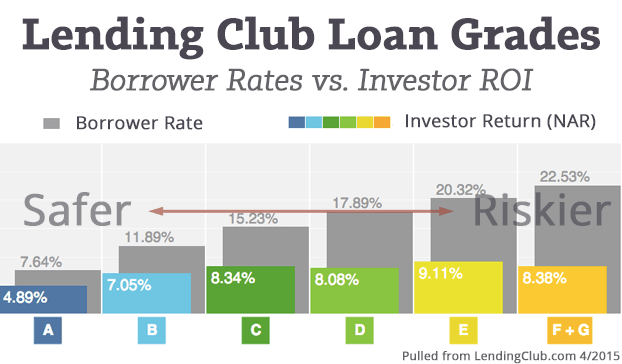
In contrast, the swing of E-G graded loans can be much wider. In 2009 these risky loans gave investors just 2.7%, while 2011 gave their investors a 9.4% return, a spread of almost 7%. And this difference could be even bigger during some future recession. You really should invest in riskier rated loans if you have a long time horizon, meaning you have more time to bounce back should you earn a poor return during recessions.
Riskier loan grades are best as a long-term investment
It is my belief that future recessions will also deliver paltry (or even negative) returns to investors in riskier C-E graded loans. But averaged over a century, these grades should reward investors with the highest average return. If you have many decades of time to put your investment to work, the riskiest graded loans seem an awesome investment to make cash grow.
[image credit: National Archives “Unemployed men in 1931” Public domain.
Hard seat sleeper “Lehman Building” CC-BY 2.0]
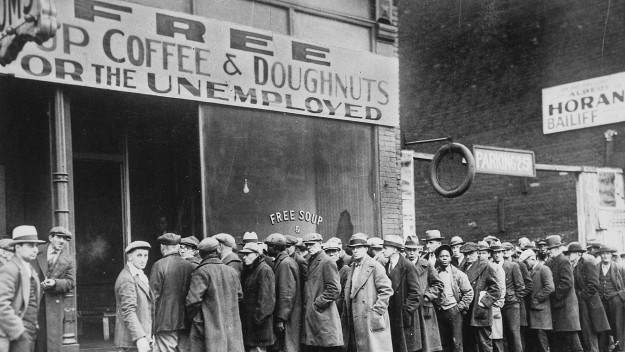
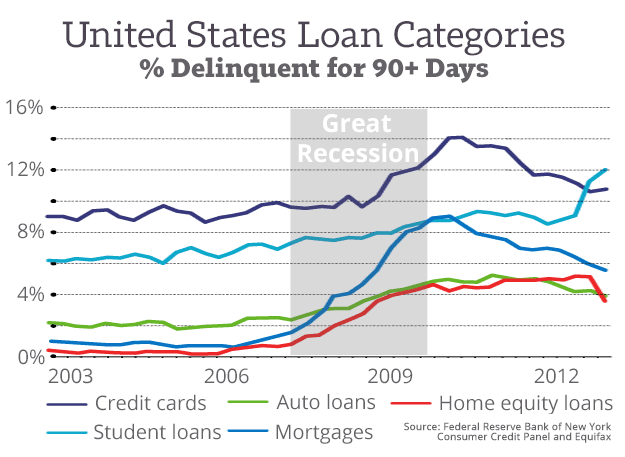
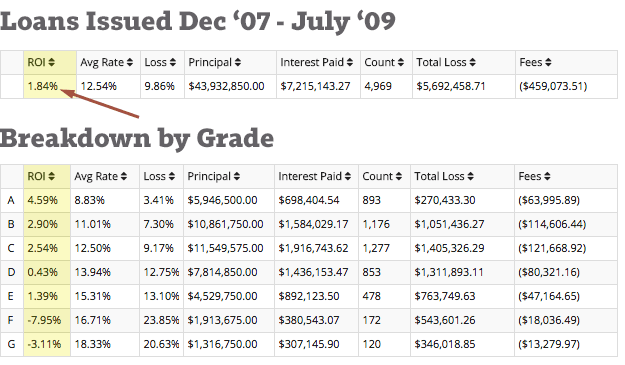
Thanks for the timely article. I’ve been considering this as well, both from a return perspective as well as a risk perspective.
One aspect of risk I’ve been wondering about lately is the prospect of a p2p bubble. As it becomes more widely known both on the investor and borrower sides, I wonder about the impact on returns over the short and long term.
It’s an interesting proposition. I’m not totally convinced about a “bubble” aspect as much as a slow degradation aspect. I’m curious if this investment may suffer future woes that arrive slowly and build upon each other, like a continual lowering of default rates for another year to the point where it loses its exceptionality alongside more traditional avenues.
I think a “bubble” is inevitable as more and more institutional lenders enter the space with leverage AND the longer we go without a spike in defaults more and more investors will price risk to a low risk environment. It is inevitable, in my opinion, that the next credit cycle turn will come with finger pointing at this industry about how participants disregarded risk. The viability of the industry will depend on stronger participants continuing to do the right thing for the industry as others compete away for market share (borrowing and lending).
The right model to watch is how rating agencies acted during the subprime debacle – they competed away to lower and lower credit requirements and were heavily criticized afterwards.
Hi Simon liked the article and particularly the comparison of p2p to credit card performance during the recession. The idea of investing EDCBA loans when things are positive and ABCDE when a recession hits makes much sense. The complication to this I guess is the myriad of other marketplace platforms (setting aside LC and Prosper) and how they perform during this recession. As for a bubble, I find it hard to believe that Central Banks and in particular the Fed, that have done so much to manage the system since the GFC will now allow rates to rise too fast and damage much of their economic repair work.
Great post. I do think we can really take the limited data we have with too much confidence.
It would be nice to have banking data that backs up the lending club data over more recessions.
Early on lending club seemed to have a fairly high learning curve. I wonder if the 2008 and 2009 data can really be relied on as similar to now. It seems to me Lending club MAY be doing a substantially better job in general of rating things and maybe avoiding the worst risks and that may have an impact on results.
It would also be much nicer to see results of loans issued a year or two before the start of a recession.
That said this article is excellent.
Thank you for your very informative article. How do you think rising interest rates will affect returns? And is there a way to invest that mitigates it? Perhaps something like dollar cost averaging so things come due at different times?
5 year loans can lock in the higher rates for longer. Other than that, just increasing in higher risk is probably the simplest way, but it’s not for everybody’s situation.
Great article, as always.
What’s the source of the “Lending Club 3-years loans”, and if you’ve created it, what’s the method for calculating those returns?
Hi Emmanuel. I made that chart myself using the data from the NSR backtester.
I wonder how LC will preform in the next crash? Credit card issuers have a lot more clients out there than an investor has in LC. If I have 800 loans that pales in comparison to the millions of credit cards out there. Will there be a problem if 50% of the loans I have default? I remember in 2008 nobody has jobs and everyone defaulted. We all have a short memory….
I really believe in P to P but I guess we will all have to wait to see what happens… For sure as always there will be another crash in the stock market nothing goes up forever except taxes.
Absolutely. Many people say that the next recession will be the thing that makes or breaks this investment.
I know I’m a year late here, but it actually isn’t nearly as bad as you thought. Just a few hundred loans really smooths out the variance. The easiest analogy is to polling: a typical political poll hits maybe 500 to 1,000 people, but actually is quite representative of the whole population. That’s what you want here: a default rate among your loans that is representative of the rate among all loans (which is completely tolerable).
Basically, random samples get pretty powerful pretty quickly.
Very interesting! I wonder though whether comparing the negative return on some lower rated loan grades to the S&P 500 is a fair comparison. If you were in the S&P 500 just before the recession, and you held on to the investment you would have recovered all of our “lost” principal, and then some. At least according to CNN Money in Feb. 2015 article: “The S&P 500 is up over 200% since the bottoming out in March 2009.” The P2P losses are essentially forever since I am guessing that most of those losses were never recovered.
Very interesting. I was wondering if lending club sees a hole in it\’s model? The ROI on the F notes during the recession makes holding G notes a much better risk. Thanks for the number crunching. I am thinking about making some changes in my acct.
What about a barbell approach? What happens if you hold two-thirds A and one-third E? Is that riskier than clustering B and C together?
Good article. I think there is one thing missing, though. The losses on the stock market were reverted in the coming years after 2009; if you were an investor with the ability to wait until 2014, you would have lost nothing, and actually made a profit to offset any losses in dividend income for the previous years.
If you were investing in P2P lending, and the loans defaulted, then that capital would have been lost forever.
Great point. I fully agree that the stock market is a much much better buy-and-hold investment. But for those who need stability (for example, elderly people with no earning power), peer to peer loans seem like they could provide refreshing stability, even within a national recession.
Great article. I’ve been very skeptical of LendingClub lately because they DO NOT have a plan for stock market crashes, but they now do not allow E, F, and G rated lenders to get loans so that does help a bit.